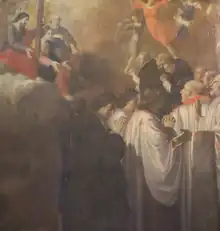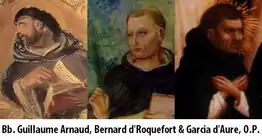Avignonet massacre
The Avignonet massacre occurred on the eve of 28 May 1242 when a small force, mainly consisting of Cathars, massacred a group of inquisitors during the Albigensian Crusade.
Blessed Martyrs of Avignonet a.k.a. "Blessed Guillaume Arnaud and 10 Companions" | |
|---|---|
 Painting depicting the Blessed Martyrs of Avignonet | |
| Martyrs | |
| Died | 28 May 1242 Avignonet, France |
| Honored in | Roman Catholic Church |
| Beatified | 6 September 1866, Rome by Pope Pius IX |
| Feast | 29 May |
| Attributes | Religious habits Martyr's palm Swords piercing their bodies Murdered by Cathars |
Guillaume Arnaud and Etienne de Saint-Thibery, the chief inquisitors of the County of Toulouse were visiting Avignonet.[1][2] Arnaud and Saint-Thibery were lodged at the castle of Raymond VII, Count of Toulouse.[1] The count's nephew, Raymond d'Alfaro sent a letter to Montsegur, where there were a number of prominent Cathars, including Pierre Roger.[1][2] The letter informed Pierre Roger that the inquisitors were in Avignonet.[2]
Pierre Roger set out for Avignonet with about 15 knights and 40 horse riding sergeants, which was about half of his Montsegur garrison.[3] Pierre Roger stopped at the town of Gaja-la-Selve, taking up a reserve position while the others continued.[1][2]
By nightfall, the raiders had arrived at Avignonet.[1] A messenger continued to give them information about the activities of the inquisitors.[1] Sympathetic locals opened the gates for the raiders[1][2][3] and twelve knights and fifteen locals marched toward the castle.[3] The raiders broke down the castle door and hacked the inquisitors to death.[1] Eleven men died.[1] The castle was then looted.[1][2]
The massacre was celebrated by Cathars in short vernacular songs (coblas esparsas).[4] Eventually, the French government decided to crack down on the Cathars, resulting in the Siege of Montségur from 1243 to 1244.[3]
Victims

The twelve victims at Avignonet were:[5]
- William Arnaud, a Dominican, the inquisitor
- Stephen of Saint-Thibéry, a Franciscan, the assistant Inquisitor
- Garcia d'Aure, a Dominican lay brother
- Bernard de Roquefort, a Dominican
- Raymond Carbonier, the representative of the bishop
- Raymond Cortisan, an archdeacon
- Pierre d'Arnaud, a lay notary
- Fortanerius, a Franciscan
- Ademar, a monk of Chiusa
- two Benedictine monks
- the prior of Avignonet
They are recognized as martyrs by the Catholic Church and were beatified on 6 September 1866 by Pope Pius IX.[5]
References
- Andrew P. Roach; James R. Simpson (2016). "Heresy and the Making of European Culture - Medieval and Modern Perspectives". Google Books. Taylor and Francis. p. 349. Retrieved 26 June 2021.
- Peter Vronsky (2002). "MONTSEGUR A BRIEF HISTORY OF THE FORTRESS - THE MASSACRE OF THE INQUISITORS AT AVIGNONET". Retrieved 26 June 2021.
- Sean McGlynn (2015). Kill Them All - Cathars and Carnage in the Albigensian Crusade. History Press. ISBN 9780750951944. Retrieved 26 June 2021.
- Léglu, Catherine (2002), "Vernacular Poems and Inquisitors in Languedoc and Champagne, ca. 1242–1249", Viator, 33: 119–121.
- Basil Watkins (2016), The Book of Saints: A Comprehensive Biographical Dictionary (8th rev. ed.), Bloomsbury, p. 766.
Further reading
- Dossat, Yves (1971). "Le massacre d'Avignonet". Cahiers de Fanjeaux. 6 (1): 343–359.
- Oldenbourg, Zoé (1961). Massacre at Montségur: A History of the Albiegensian Crusade. Translated by Peter Green. Pantheon Books.